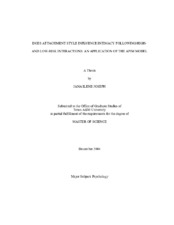| dc.description.abstract | This study examined the relation between attachment characteristics and intimacy experienced after one’s attachment style is activated. Attachment theory states that when an individual feels threatened by an attachment figure, attachment style is activated and dictates how that individual relates to his or her partner in that situation. This study tests this theory. Data were collected on 110 committed romantic couples from the community. Each individual completed a series of questionnaires, including the Adult Attachment Questionnaire. Couples then engaged in a series of four videotaped interactions in which both partners had an opportunity to discuss times in which their feelings were hurt by someone other than their partner and times in which their feelings were hurt by their partner. These interactions were regarded as low- and high-risk, respectively. The high-risk interaction was specifically targeted to activate attachment style and elicit attachment behaviors. Analyses were conducted using the Actor-Partner Interdependence Model (APIM). This model takes into account the interdependence of observations between partners. As a function of this model, both actor effects (the effect one’s own attachment style has on one’s own experiences of intimacy) and partner effects (the effect one’s own attachment style has on one’s partner’s experiences of intimacy) were examined. Intimacy was conceptualized in two different manners: state (post-interaction intimacy) and trait (overall intimacy in the relationship). It was hypothesized that individuals with insecure attachment characteristics would report lower feelings of both state and trait intimacy compared to securely attached individuals. It was also predicted that the partners of individuals with insecure attachment characteristics would report lower state and trait intimacy following the high-risk interaction compared to partners of secure individuals. The results of this study supported these hypotheses. Models testing the effect of the attachment characteristics avoidance, ambivalence, and avoidance-x-ambivalence found a relation between the presence of insecure attachment characteristics and lower levels of both state and trait intimacy. Implications of these results and future directions of study are discussed. | en |


